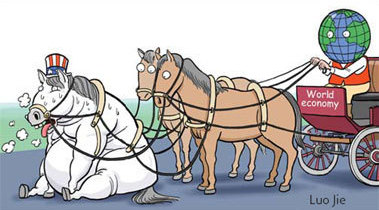The global economic party is over
By Hans-Werner Sinn (China Daily)
Updated: 2008-03-12 07:21
Updated: 2008-03-12 07:21
With the United States bordering on recession, the global economic boom has ended. The boom was unusually long and persistent, with four years of roughly 5 percent growth - a period of sustained economic dynamism not seen since 1970.
The clearest sign that the boom is ending is the International Monetary Fund's forecast of 1.5 percent growth for the US in 2008. That may not sound like a recession, but the IMF's marginally positive projection primarily reflects the growth overhang from 2007, with hardly any new contribution in 2008. It is compatible with three consecutive quarters of zero growth in 2008.
Many argue that a US recession will no longer affect the world because China has supplanted America as an engine of the global economy.
Wrong. Although China is growing fast, its economic power remains tiny. While the US contributes 28 percent to world GDP, China accounts for only 5 percent. The whole of Asia, from Turkey to China, contributes 24 percent, less than the US alone.
At some stage, the world may no longer catch a cold when the US sneezes, but that is far from being true now. Twenty-one percent of China's exports and 23 percent of the European Union's exports to non-member countries go to the US. Thus, the world cannot help but be pulled down by a US slump.

The most recent CESifo World Economic Survey (WES) from 90 countries confirms this. Assessments of the current economic situation and expectations for the next six months have worsened everywhere.
In both Western and Eastern Europe, the index sank more than in Asia or Latin America. The decline in the WES indicator during the last two quarters was the sharpest since 2001, when the stock market bubble burst.
In the US, the WES indicator is now below the level of September 11, 2001 and so is the Michigan index of consumer confidence.
For many years, the US has lived beyond its means: a household saving rate close to zero and investment financed solely with foreign funds.
The US current account deficit, which is identical to net capital imports, grew steadily to an annual $811 billion in 2006, or 6 percent of GDP - by far the largest since the Great Depression.
Year after year, the US managed to sell its assets abroad and enjoy the high life at home. No longer. The world has caught on.
Banks everywhere are learning the hard way that the debt with which the US financed its consumption boom will not necessarily be repaid. The mortgage-backed securities that US banks succeeded in selling to the world are not comparable to European assets with similar names.
In Europe, particularly Germany, a mortgage-backed security (Pfandbrief) is an ultra-safe asset, as normally banks finance no more than 60 percent of a house's value.
By contrast, such US securities are like a lottery ticket. US banks finance up to 100 percent of a house's value, sometimes even more, and the subprime market even includes loans to people without jobs and income.
Many European banks may not have understood this, yet they still shied away from revealing these dubious investments on their balance sheets. Instead, they placed them in conduits based in low-tax countries.
Those conduits are now showing gigantic losses that have to be covered by the parent banks, some of which are being driven to the brink of bankruptcy. This spring will show the necessary write-offs in the annual balance sheets, but the full truth will not become known before the balance sheets are published in the spring of next year.
As American assets have lost their attractiveness, their prices have dropped. This has meant either a decline in asset prices quoted in dollars or in dollars quoted in other currencies. Indeed, adjusted for inflation, the dollar is now nearly as low against the euro as it was against the deutschmark in 1992, when German unification resulted in the breakdown of the European currency system.
The prices of US homes are also declining at an accelerating rate, in many areas by more than 10 percent per year. The prices of traded mortgage-backed securities have followed house prices down.
Only US stock market prices have remained relatively stable. But it is only a matter of time until they fall, too. After all, the Standard & Poor's US price-earnings ratio is still above its long-term average - 26.84 in 2007, compared to its long-term average since 1881 of 16.31.
This asset meltdown is the reason for the likely recession. First, consumers, faced with tighter credit and falling house values, will need to cut spending, slowing the US economy and affecting all countries via world trade.
Second, with banks losing substantial amounts of equity capital - estimates now reach $300 billion and more - the need to maintain minimum equity-debt ratios will force them to curtail business lending, hindering investment demand.
True, the US Federal Reserve has tried to prevent a recession by cutting its interest rates. But the Fed cannot endow the banks with new equity capital and prevent a credit crunch.
More promising is the $150 billion tax cut that the US Congress recently enacted. Equivalent to 1 percent of US GDP, it is large by all accounts. Whether it is enough to compensate homeowners for the wealth losses resulting from declining house prices and to prevent the impending recession remains to be seen. But, whatever happens, the party is over.
The author is professor of economics and finance, University of Munich, and president of the Ifo Institute Project Syndicate
(China Daily 03/12/2008 page10)
|
|
|
|
|
|